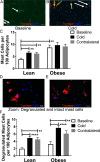Adipose Tissue Mast Cells Promote Human Adipose Beiging in Response to Cold
- PMID: 31209239
- PMCID: PMC6572779
- DOI: 10.1038/s41598-019-45136-9
Adipose Tissue Mast Cells Promote Human Adipose Beiging in Response to Cold
Abstract
In a recent study, repeated cold application induced beiging in subcutaneous white adipose tissue (SC WAT) of humans independent of body mass index. To identify factors that promote or inhibit beiging, we performed multiplex analysis of gene expression with the Nanostring nCounter system (the probe set contained genes for specific immune cell markers, cytokines, and chemokines) on the SC WAT from lean subjects. Multiple correlations analysis identified mast cell tryptase and CCL26, a chemokine for mast cells, as genes whose change correlated positively with the change in UCP1 in SC WAT, leading to the hypothesis that mast cells promote SC WAT beiging in response to cold. We quantified mast cell recruitment into SC WAT and degranulation. Mast cells increased in number in SC WAT in lean subjects, and there was an increase in the number of degranulated mast cells in both lean subjects and subjects with obesity. We determined that norepinephrine stimulated mast cell degranulation and histamine release in vitro. In conclusion, cold stimulated adipose tissue mast cell recruitment in lean subjects and mast cell degranulation in SC WAT of all research participants independent of baseline body mass index, suggesting that mast cells promote adipose beiging through the release of histamine or other products.
Conflict of interest statement
The authors declare no competing interests.
Figures



Similar articles
-
Mast Cells Promote Seasonal White Adipose Beiging in Humans.Diabetes. 2017 May;66(5):1237-1246. doi: 10.2337/db16-1057. Epub 2017 Mar 1. Diabetes. 2017. PMID: 28250021 Free PMC article.
-
Human adipose beiging in response to cold and mirabegron.JCI Insight. 2018 Aug 9;3(15):e121510. doi: 10.1172/jci.insight.121510. eCollection 2018 Aug 9. JCI Insight. 2018. PMID: 30089732 Free PMC article. Clinical Trial.
-
Overexpression of Adiponectin Receptor 1 Inhibits Brown and Beige Adipose Tissue Activity in Mice.Int J Mol Sci. 2021 Jan 18;22(2):906. doi: 10.3390/ijms22020906. Int J Mol Sci. 2021. PMID: 33477525 Free PMC article.
-
Beiging of white adipose tissue as a therapeutic strategy for weight loss in humans.Horm Mol Biol Clin Investig. 2017 Jun 23;31(2):/j/hmbci.2017.31.issue-2/hmbci-2017-0016/hmbci-2017-0016.xml. doi: 10.1515/hmbci-2017-0016. Horm Mol Biol Clin Investig. 2017. PMID: 28672737 Review.
-
Transcriptional regulation of the uncoupling protein-1 gene.Biochimie. 2017 Mar;134:86-92. doi: 10.1016/j.biochi.2016.09.017. Epub 2016 Oct 5. Biochimie. 2017. PMID: 27693079 Review.
Cited by
-
Immune Cells in Thermogenic Adipose Depots: The Essential but Complex Relationship.Front Endocrinol (Lausanne). 2022 Mar 14;13:839360. doi: 10.3389/fendo.2022.839360. eCollection 2022. Front Endocrinol (Lausanne). 2022. PMID: 35360060 Free PMC article. Review.
-
Macrophages expressing uncoupling protein 1 increase in adipose tissue in response to cold in humans.Sci Rep. 2021 Dec 8;11(1):23598. doi: 10.1038/s41598-021-03014-3. Sci Rep. 2021. PMID: 34880313 Free PMC article.
-
Identification of Molecular Mechanisms Related to Pig Fatness at the Transcriptome and miRNAome Levels.Genes (Basel). 2020 May 29;11(6):600. doi: 10.3390/genes11060600. Genes (Basel). 2020. PMID: 32485856 Free PMC article.
-
Adipose Tissue Immunomodulation: A Novel Therapeutic Approach in Cardiovascular and Metabolic Diseases.Front Cardiovasc Med. 2020 Nov 17;7:602088. doi: 10.3389/fcvm.2020.602088. eCollection 2020. Front Cardiovasc Med. 2020. PMID: 33282920 Free PMC article. Review.
-
In Patients With Obesity, the Number of Adipose Tissue Mast Cells Is Significantly Lower in Subjects With Type 2 Diabetes.Front Immunol. 2021 May 21;12:664576. doi: 10.3389/fimmu.2021.664576. eCollection 2021. Front Immunol. 2021. PMID: 34093556 Free PMC article.
References
-
- Kern Philip A., Finlin Brian S., Zhu Beibei, Rasouli Neda, McGehee Robert E., Westgate Philip M., Dupont-Versteegden Esther E. The Effects of Temperature and Seasons on Subcutaneous White Adipose Tissue in Humans: Evidence for Thermogenic Gene Induction. The Journal of Clinical Endocrinology & Metabolism. 2014;99(12):E2772–E2779. doi: 10.1210/jc.2014-2440. - DOI - PMC - PubMed
Publication types
MeSH terms
Substances
Grants and funding
LinkOut - more resources
Full Text Sources
Medical

